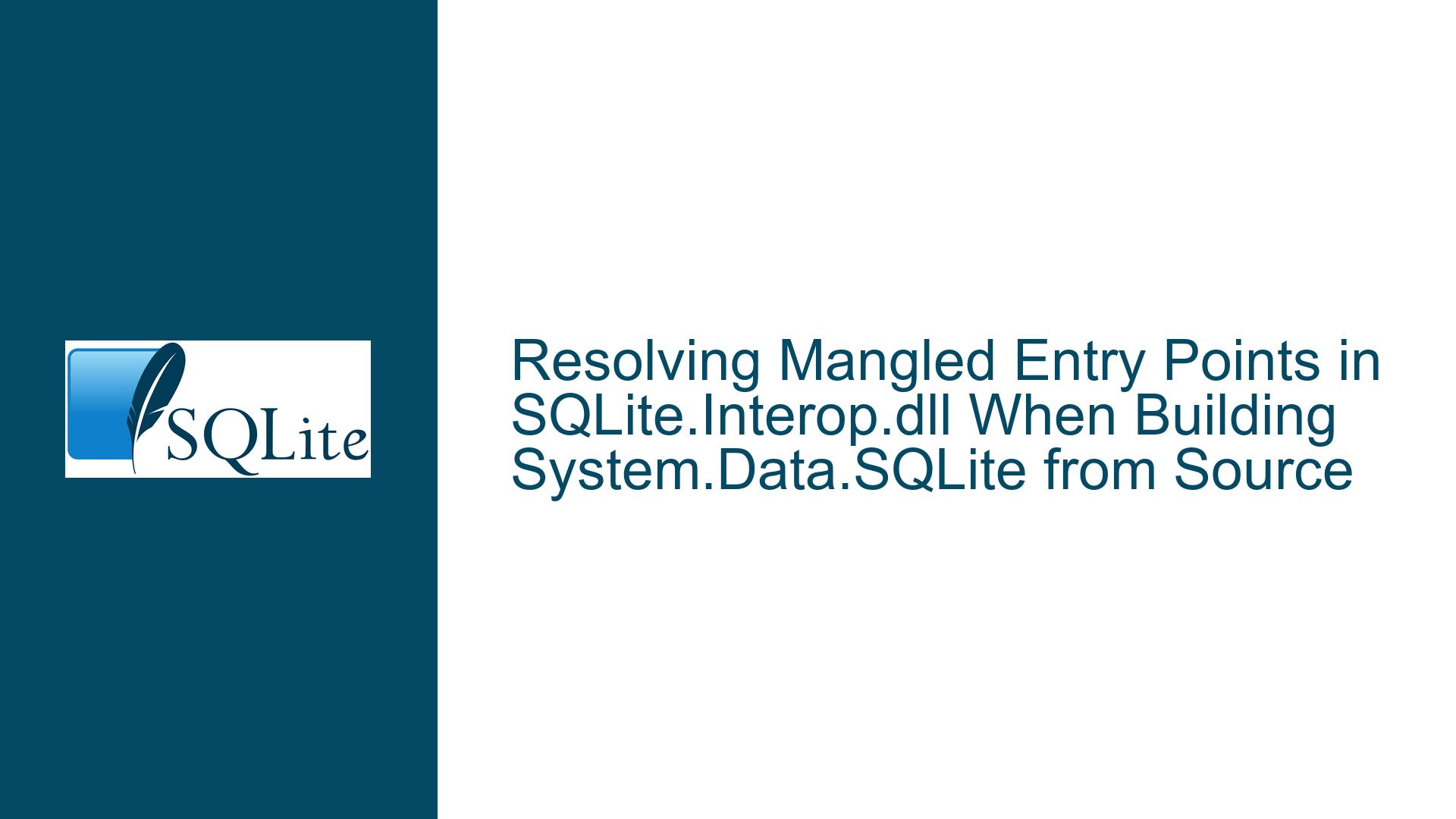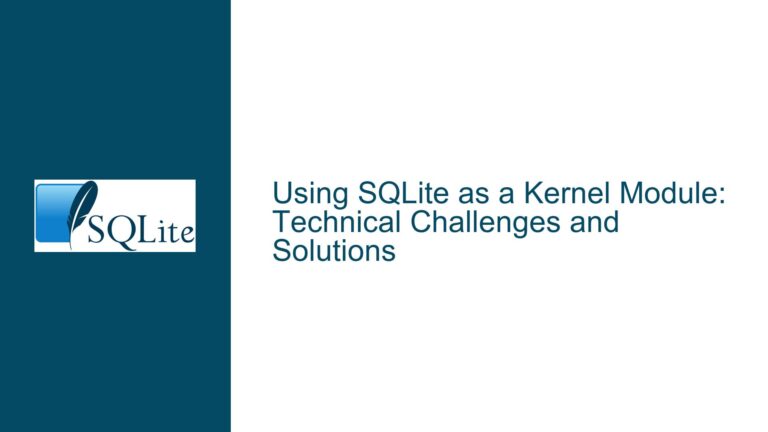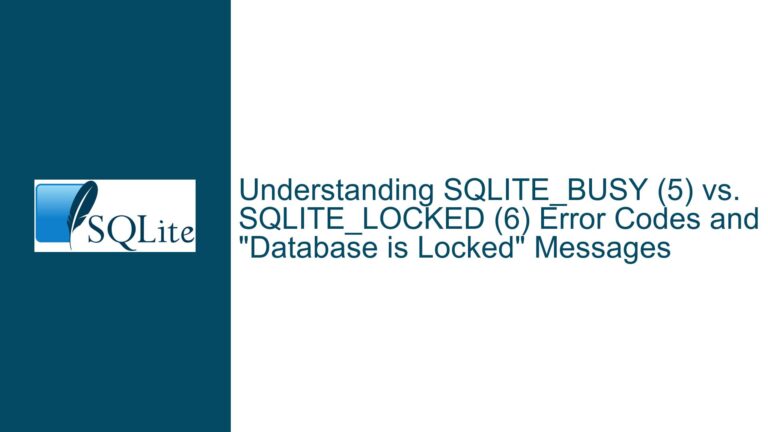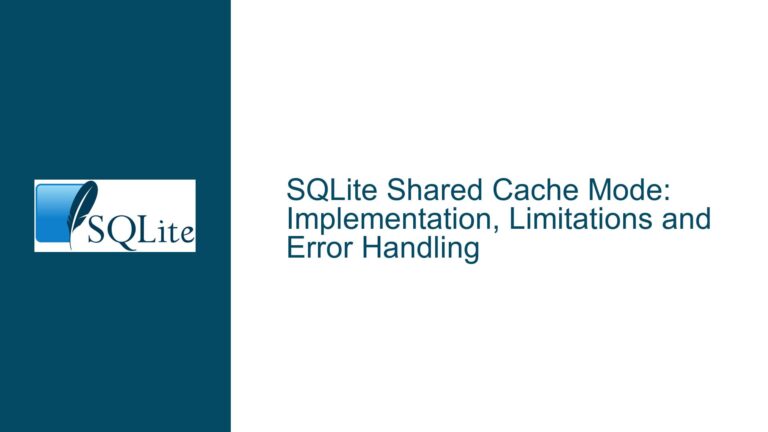Resolving Mangled Entry Points in SQLite.Interop.dll When Building System.Data.SQLite from Source
Issue Overview: Mismatched Entry Points Between Managed System.Data.SQLite and Native SQLite.Interop.dll
When integrating the managed System.Data.SQLite library with the native SQLite.Interop.dll, a critical requirement is that the managed assembly must locate and bind to specific exported functions (entry points) in the native DLL. These entry points are the bridges between the .NET runtime and the underlying SQLite engine. If these entry points are "mangled" or altered due to build misconfigurations, the managed code will fail to interact with the native library, resulting in errors such as "Unable to find entry point" or "DLLNotFoundException".
In this scenario, the user compiled System.Data.SQLite from source but encountered a mismatch between the entry points expected by the managed assembly and those exposed by the official SQLite.Interop.dll. The problem arose because the native DLL’s exported function names were not in the format required by the managed layer. After rebuilding the native DLL with specific configurations (ReleaseNativeOnlyStatic for x64 and Win32), the issue was resolved, as the rebuilt DLL exposed plain (unmangled) function names.
The root of this problem lies in the interplay between build configurations, compiler settings for native code, and the expectations of the managed assembly. Mangled entry points often stem from differences in how compilers encode function names (e.g., C++ name mangling vs. C-style exports) or static vs. dynamic linking configurations. The System.Data.SQLite library requires the native DLL to export functions using C-style naming conventions (no name decoration) and to ensure that the architecture (x86/x64) matches between both components.
Possible Causes: Build Configuration, Compiler Settings, and Architecture Mismatches
1. Incorrect Build Configuration for Native SQLite.Interop.dll
The System.Data.SQLite project includes multiple build configurations for the native DLL, such as Debug, Release, ReleaseNativeOnly, and ReleaseNativeOnlyStatic. Each configuration alters how the native code is compiled and linked:
ReleaseNativeOnlyStatic: Links the C runtime (CRT) statically and avoids dependencies on external CRT DLLs. This configuration often forces the compiler to use C-style function exports (no name mangling) if the project is configured correctly.ReleaseNativeOnly: Dynamically links the CRT, which can introduce subtle differences in symbol visibility or dependencies.- Debug configurations: May enable additional debug symbols or assertions, which can affect function signatures.
If the native DLL is built with a configuration that enables C++ name mangling (e.g., using extern "C++" instead of extern "C"), the exported function names will include compiler-specific decorations (e.g., _SQLite3_open@8 instead of sqlite3_open). The managed assembly expects undecorated names, so mismatched configurations lead to unresolved entry points.
2. Static vs. Dynamic Linking of the C Runtime (CRT)
Static linking (/MT or /MTd in MSVC) embeds the CRT into the native DLL, eliminating dependencies on msvcrt.dll but increasing binary size. Dynamic linking (/MD or /MDd) relies on the system’s CRT. However, static linking can influence how functions are exported, especially if the linker is instructed to strip unnecessary symbols. The ReleaseNativeOnlyStatic configuration ensures static linking and often enables linker optimizations to export only essential SQLite functions without name mangling.
3. Architecture-Specific Builds (x86 vs. x64)
The managed System.Data.SQLite assembly is architecture-sensitive. If the native DLL is built for x86 but the managed code targets x64 (or vice versa), the runtime will fail to load the DLL, leading to errors. Furthermore, even if the architectures match, inconsistencies in calling conventions (e.g., stdcall vs. cdecl) can alter function signatures. SQLite uses cdecl by default, and deviations from this will corrupt entry points.
4. Incorrect Use of Preprocessor Definitions or Export Attributes
The SQLite source code uses preprocessor directives like SQLITE_API to control symbol visibility. For example:
#ifdef _WIN32
# define SQLITE_API __declspec(dllexport)
#else
# define SQLITE_API
#endif
If these macros are redefined or omitted during compilation, the linker may not export the required functions. Similarly, failing to wrap C++ code in extern "C" blocks will result in C++ name mangling, which the managed assembly cannot resolve.
5. Version Mismatches Between Components
The managed System.Data.SQLite and native SQLite.Interop.dll must be built from compatible source versions. If the managed assembly expects functions added in SQLite 3.40.0 but the native DLL is built from SQLite 3.39.0, entry points will be missing. Similarly, custom modifications to either component can introduce incompatibilities.
Troubleshooting Steps, Solutions & Fixes: Aligning Build Configurations and Validating Exports
Step 1: Rebuild the Native SQLite.Interop.dll with Correct Configurations
- Use
ReleaseNativeOnlyStaticfor Both Architectures: This configuration ensures static linking of the CRT and optimizes the native DLL for compatibility with the managed assembly. In Visual Studio, select theReleaseNativeOnlyStaticconfiguration for bothx86andx64platforms before building. - Verify Build Scripts or IDE Settings: If building via command line, ensure that the build script invokes
msbuildwith the correct parameters:msbuild SQLite.Interop.vcxproj /p:Configuration=ReleaseNativeOnlyStatic /p:Platform=Win32 msbuild SQLite.Interop.vcxproj /p:Configuration=ReleaseNativeOnlyStatic /p:Platform=x64 - Inspect Compiler Flags: Confirm that the following flags are set in the project:
/MT(Multithreaded Static CRT)/D "NDEBUG"(Disable Debug Symbols)/D "SQLITE_ENABLE_API_ARMOR"(If applicable)- No C++ exceptions or RTTI enabled.
Step 2: Validate Exported Functions in SQLite.Interop.dll
Use tools like Dependency Walker, dumpbin, or objdump to inspect the exported functions:
- For Windows:
dumpbin /exports SQLite.Interop.dllLook for unmangled names like
sqlite3_open,sqlite3_close, etc. Mangled names will appear as_sqlite3_open@8or?sqlite3_open@@YAHPEAD@Z. - For Linux/macOS:
objdump -T SQLite.Interop.so - Fixing Mangled Names:
If functions are mangled, ensure that all SQLite API functions are wrapped inextern "C"blocks in the source code. For example:#ifdef __cplusplus extern "C" { #endif SQLITE_API int sqlite3_open(const char *filename, sqlite3 **ppDb); #ifdef __cplusplus } #endifRebuild the native DLL after applying these changes.
Step 3: Ensure Architecture Consistency Between Components
- Match Managed and Native Architectures: Deploy the
x86native DLL with a 32-bit managed assembly and thex64DLL with a 64-bit assembly. Mixed architectures will cause runtime failures. - Check Project Build Settings: In Visual Studio, ensure that the solution platform (e.g.,
x86,x64) aligns with the native DLL’s architecture. Use the Configuration Manager to verify this.
Step 4: Update or Revert to Stable Versions
- Sync Source Code Revisions: Ensure that both the managed System.Data.SQLite and native SQLite engine are from the same source revision. For example, use the
1.0.118tag for both components if that’s the version referenced in the error. - Avoid Custom Modifications: If you’ve altered the SQLite source, revert to a clean version to rule out self-introduced issues.
Step 5: Debug Loader Issues with Process Monitor
Use Process Monitor (ProcMon) to trace DLL loading attempts:
- Filter by Process Name = your application.
- Look for NAME NOT FOUND or ACCESS DENIED errors for
SQLite.Interop.dll. - Ensure the DLL is located in the correct directory (e.g.,
bin\x86\Releaseorbin\x64\Release).
Step 6: Manual Deployment and Dependency Checks
- Deploy the Native DLL Alongside the Managed Assembly: The native DLL must reside in a subdirectory named
x86orx64adjacent to the managed DLL. For example:Application.exe x86/ SQLite.Interop.dll x64/ SQLite.Interop.dll - Install Redistributable Packages: For dynamically linked builds, ensure the target machine has the correct Visual C++ Redistributable installed.
Step 7: Rebuild the Entire Solution from Scratch
- Clean Intermediate Files: Delete all
obj,bin, andInteropdirectories to eliminate stale artifacts. - Rebuild in a Clean Environment: Use a fresh clone of the repository and avoid incremental builds.
By systematically addressing build configurations, symbol exports, and deployment layouts, you can resolve entry point mismatches between System.Data.SQLite and SQLite.Interop.dll. The key is to enforce C-style function exports in the native DLL and maintain strict consistency across architectures and versions.






